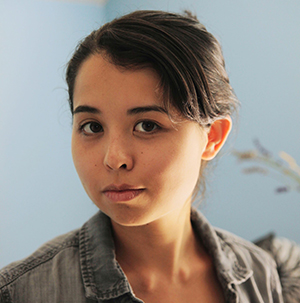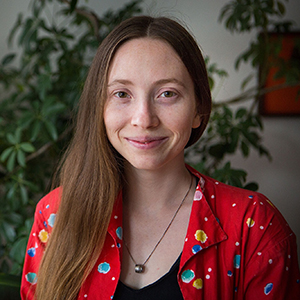Irrefutably Alive: Claire Majors in Conversation with Laura Ritland

Malahat Review volunteer Claire Majors talks with Laura Ritland, judge for our 2022 Far Horizons Award for Poetry contest (and previous winner of our 2014 contest). They discuss the constructed nature of poetry, the benefits of form constraints, and how elastic and capacious craft can be.
Laura Ritland is a poet, teacher, and scholar raised on the unceded Coast Salish territories of Vancouver. She is the author of the poetry collection East and West, published with Véhicule Press in 2018, and the chapbook Marine Science, published with Anstruther Press. Her poetry has been shortlisted for the Pat Lowther Memorial Award, nominated for the Gerald Lampert Memorial Award, won The Malahat Review's Far Horizons Award for Poetry, and featured and anthologized in publications across Canada including In Fine Form (edited by Kate Braid and Sandy Shreve), The Walrus, Canadian Notes & Queries, Maisonneuve, The Fiddlehead, and The Malahat Review. She currently lives on Huichin, Ohlone land, in Berkeley, California, where she is writing a doctoral dissertation at UC Berkeley about the history of literary criticism, public education, and democracy.
What are you looking for in the winning poem? What will be the deciding factor between the shortlisted entries and the winning entry?
I’ll be looking for how the way the poem is made, its particular construction, feels more than just a demonstration of an idea, story, or concept—feels irrefutably alive in itself. And I’m also looking for risk: whether that be in the use of craft or in the kind of story that it tells. Hopefully that’s open-ended enough without being entirely vague!
Your poem "Vincent, in the Dream of Zundert," was chosen out of almost 800 entries for the 2014 Far Horizons Award for Poetry. How did winning this award affect your writing career?
It was monumental. Professionally, it was the first time my work reached a wider audience, putting me in touch with many wonderful readers, writers, and editors. The prize also helped open doors towards my first book contract.
Personally, it bolstered my confidence at a time when I felt very unsure of my capabilities as a writer. Actually, I had almost decided not to submit an entry to the contest—I was convinced I’d never win. So, the prize has been an ongoing reminder of the importance of putting self-risk over self-doubt—and of how pre-emptively judging oneself might preclude a lot of potentially terrific outcomes.
Why did you choose to write “Vincent, in the Dream of Zundert” as a pantoum (a series of quatrains with a system of repeated lines, similar to a villanelle)? What value do you think classic poetic forms can add to contemporary poetry?
At the time, I was on a form poetry kick. Writing in traditional forms was giving me a better grasp of poetic form itself—as if by building a table, I could learn something about woodworking. In the pantoum form, as you’ve mentioned, new lines recirculate and repeat among old ones in a kind of hypnotic way. It felt right for the spiralling grief and longing I was trying to communicate here. (Indeed, I’ve often thought of grieving as a spiral for the way it retreads and replays the past but in slightly different iterations).
I think that classic poetic forms, through their heightened constraints, urge us to attend more closely to the formal dimension that is always there in poetry. While they may sound clunky and artificial to our contemporary ear, it’s this very artificiality, I think, that reminds us of the constructed nature of poetry, its “madeness.” A lot of terrific work is also being done today where poets are inhabiting or riffing on classic poetic forms in order to highlight forms of social and political constraint. I think of Terrance Hayes’s and Sonnet L’Abbé’s work with the sonnet, for example.
Do you ever look back at certain of your old poems and cringe? When did you begin writing poetry, and what have you learned about the craft since then?
Absolutely. Cringing seems part of the profession of being a poet. I mean, what could be more cringe-worthy than telling someone you’re a poet? On the other hand, I think something is usually cringe because it has taken a risk to be vulnerable—and I think that motive is to be admired. That’s just part of making art. A lot of cringe might need to happen before you get to making something really good.
I began writing poetry when I was a teenager, as a creative outlet alongside visual art. The best thing about craft I’ve learned is just how elastic and capacious it can be. You can have everything from the lyric confessional poem to epics made of collaged bits of newspaper.
Are there any poems that you have read that have stayed with you for years? What quality do you think makes a poem linger in the psyche?
To name just two… Elizabeth Bishop’s “One Art” has lingered with me (speaking of form poetry—it’s a villanelle). Karen Solie’s “Migration” is one of my all-time favourites of one of my favourite poets.
There’s something about the impossibility of these poems being anything other than what they are—the astonishing this-ness of them—that makes them unforgettable for me.
What do “showing” and “telling” mean to you in poetry, and how do you determine that these elements are balanced?
The more I think about this question, the more it strikes me as getting at the heart of a very interesting issue in poetry. The advice traditionally given in poetry workshops is that poetry should find a way to “tell” by “showing”—if you are trying to convey a story about a family secret, maybe you’ll use the motif of locked cabinets, for example. I think this is generally very sound advice. On the other hand, whole other poetic traditions have emerged around formal experimentation rather than on conveying content. You’d be hard-pressed to say what Gertrude Stein’s Tender Buttons is really “about,” for example. In this case, I think, it’s sort of more “show” rather than “tell”—because the very language itself, the way it formally operates on the reader, is the point of what it is.
Neither of these paths are automatically the “right” way. The most exciting poetry, I’ve found, just doesn’t take for granted the relation between form and content, showing and telling—it finds its own way through the binary, whether that be in finding an extremely beautiful formulation between the two or shaking up language itself.
So, I don’t think there is one right balance. I know that’s not very helpful, though, so I’ll also add that with my students I often encourage them to ask: “Does this line or section communicate what we already know? Does it seem to repeat an established idea?” If so, it might need to be cut or revised. Often, out of an anxiety to be understood, we might veer too hard into “telling” where we should give room for the reader to meet us halfway. And if you’re worried that your poem’s story or meaning isn’t coming across—that the “telling” is too oblique or confusing—it’s always good protocol to find a reader who can act as your guinea pig. You might need to add more details to direct the reader, depending on their reaction.

Claire Majors
* * * * * * * *









